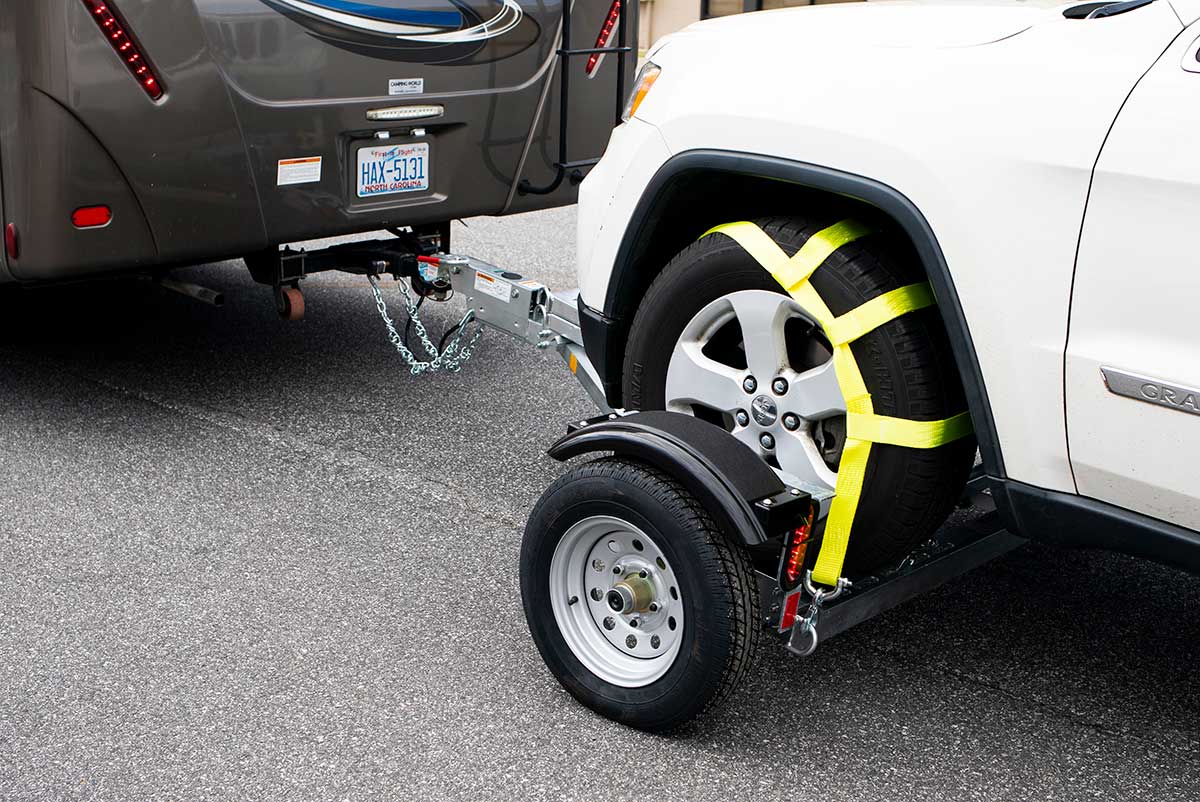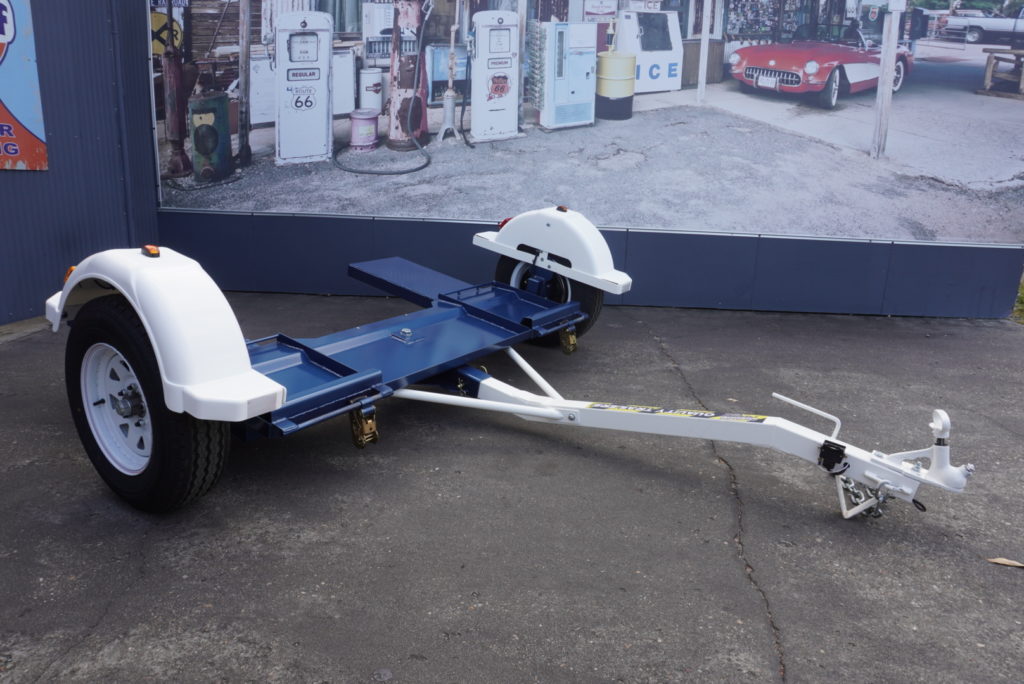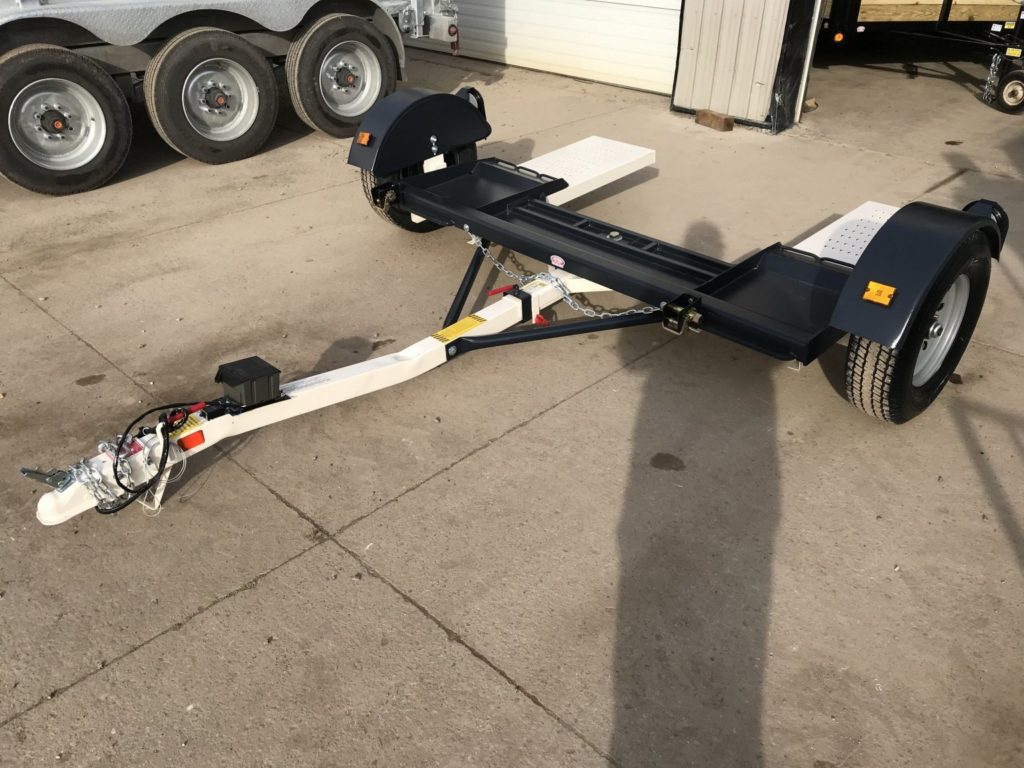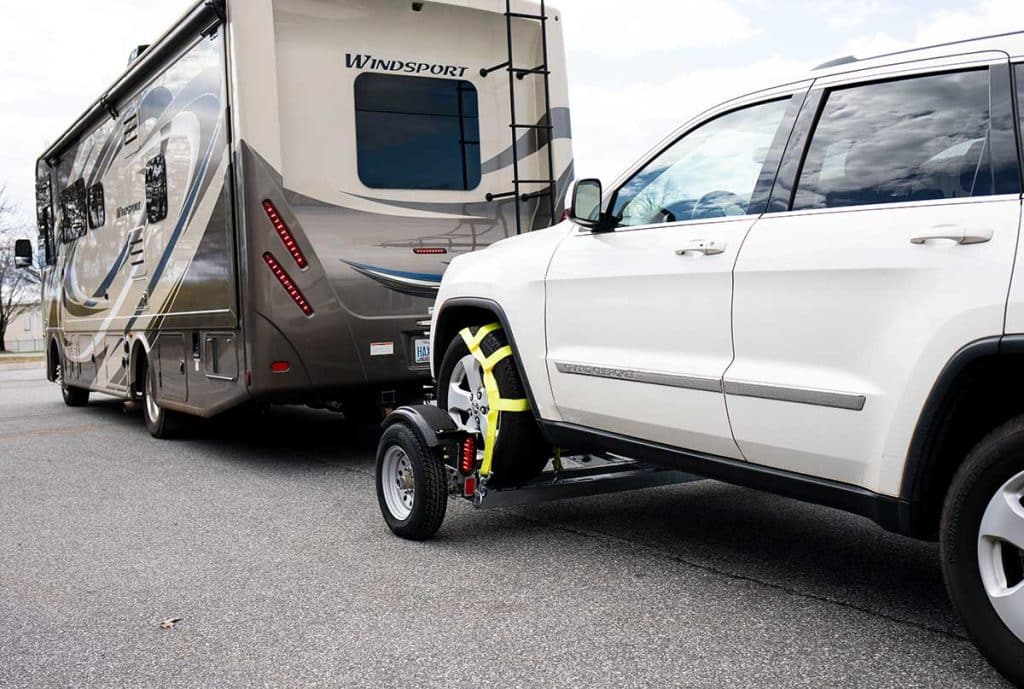What Is a Tow Dolly (Detailed Analysis)
When it comes to transporting vehicles, a tow dolly is a valuable tool that provides a practical and cost-effective solution. Whether you’re moving to a new location or embarking on a road trip, understanding what a tow dolly is and how it works can be incredibly beneficial.
A tow dolly, also known as a car dolly or car tow dolly, is a specialized trailer designed specifically for towing a vehicle behind another vehicle. It is commonly used when the towed vehicle cannot be driven, either due to mechanical issues or other constraints. The purpose of a tow dolly is to lift the rear wheels of the towed vehicle off the ground while keeping the front wheels on the road, allowing for safe and convenient transportation.
The working process of a tow dolly involves a few key components. It typically consists of a sturdy frame, two ramps, and a tow hitch. The rear wheels of the towed vehicle are placed on the tow dolly, secured with straps or chains, and elevated off the ground. The front wheels of the towed vehicle remain in contact with the road, enabling the vehicle to be safely towed by another vehicle.
One of the primary advantages of using a tow dolly is its compatibility with front-wheel-drive vehicles. It is particularly well-suited for this type of vehicle, as the dolly lifts the non-driven rear wheels off the ground, allowing the front wheels to roll freely. This eliminates the need for a full trailer and provides a more cost-effective option for towing front-wheel-drive cars.
Overall, a tow dolly serves as a practical and efficient means of towing a vehicle when only the rear wheels need to be lifted off the ground. It offers convenience, affordability, and compatibility for front-wheel-drive cars, making it a popular choice for vehicle transportation.
What Is a Tow Dolly? How Does It Work?
When it comes to transporting vehicles, a tow dolly is an invaluable tool. It provides a convenient and cost-effective solution for towing a car behind another vehicle, especially when the towed vehicle cannot be driven. Whether you’re moving or taking a road trip, understanding what a tow dolly is and how it works can save you time and effort.
A tow dolly, also known as a car dolly or car tow dolly, is a specialized trailer designed to carry a vehicle with its rear wheels off the ground. It typically consists of a robust frame, two ramps, and a tow hitch. The rear wheels of the towed vehicle are placed on the dolly, secured with straps or chains, and lifted off the ground. The front wheels of the towed vehicle remain on the road while being safely transported.
The mechanism behind a tow dolly is fairly straightforward. The dolly’s ramps allow the front wheels of the vehicle to be driven onto the dolly, positioning the vehicle securely. Once the vehicle is in place, the front wheels are locked into position, preventing any unnecessary movement during transport. The dolly is then connected to the towing vehicle using a tow hitch, ensuring a stable and controlled towing experience.
Using a tow dolly offers several advantages. It enables the towing of a front-wheel-drive vehicle without the need for a full trailer, which can be more expensive and challenging to maneuver. Additionally, it provides an alternative when the tow vehicle cannot be driven due to mechanical issues or other constraints.
However, it’s crucial to remember that not all vehicles are suitable for towing with a dolly. Some four-wheel-drive, all-wheel-drive, or rear-wheel-drive vehicles may require alternative towing methods, such as a flatbed trailer, to ensure all wheels are off the ground.
In conclusion, a tow dolly is a practical solution for towing a car when only the rear wheels need to be lifted off the ground. By understanding how it works and its limitations, you can make informed decisions about using a tow dolly for your transportation needs.
What Are the Pros of a Tow Dolly?
Tow dollies offer numerous benefits when it comes to transporting vehicles. These specialized trailers provide a practical and efficient solution for towing, making them a popular choice among vehicle owners. Let’s explore some of the pros of using a tow dolly.
- Cost-Effective: Tow dollies are generally more affordable compared to full trailers or flatbed trucks. They offer a budget-friendly option for those who need to transport their vehicles without breaking the bank. Check how much it cost to move cross country.
- Maneuverability: Tow dollies are designed to be compact and lightweight, making them easier to maneuver and navigate through tight spaces. This can be particularly advantageous in crowded parking lots or narrow streets where larger trailers may face difficulties.
- Versatility: Car dollies are well-suited for front-wheel-drive cars. Whether you’re moving or embarking on a road trip, a tow dolly can efficiently transport your front-wheel-drive vehicle without the need for additional equipment or modifications.
- Accessibility: Owning a tow dolly provides you with the flexibility to transport your vehicle on your terms. You can easily hook up the dolly to a towing vehicle and hit the road whenever needed, without relying on specialized towing services.
- Fuel Efficiency: Tow dollies tend to be lighter than full trailers, resulting in improved fuel efficiency. By using a tow dolly, you can save on fuel costs while still ensuring the safe transportation of your vehicle.
- Easy Storage: Unlike car trailers, tow dollies are typically more compact and easier to store. They require less space in your garage or storage area, allowing you to make the most of the available room.
In conclusion, tow dollies offer several advantages for towing front-wheel-drive cars. From cost-effectiveness to maneuverability and versatility, these specialized trailers provide an efficient and convenient solution for transporting vehicles. If you own a front-wheel-drive car and need to tow it, considering a tow dolly can be a practical choice that meets your transportation needs without breaking the bank.
What Are the Cons of a Tow Dolly?
While tow dollies provide a practical solution for towing vehicles, it’s important to consider their limitations and potential drawbacks. Understanding the cons of using a tow dolly can help you make an informed decision about the best towing method for your specific needs. Let’s explore some of the cons associated with tow dollies.
- Weight Capacity Limitations: Tow dollies have specific weight capacity limits. It’s crucial to ensure that the weight of the towed vehicle falls within the dolly’s recommended capacity. Exceeding this limit can lead to unsafe towing conditions and potential damage to both the dolly and the vehicle.
- Two-Wheel Towing: Tow dollies only lift the front wheels of the towed vehicle off the ground. This means that the rear wheels of the towed vehicle remain in contact with the road. As a result, there is a risk of wear and tear on the rear tires of the towed vehicle during transportation, especially during long journeys.
- Additional Storage Space: Owning a tow dolly requires additional storage space when it is not in use. Unlike flatbed car trailers that can be folded or detached, tow dollies can take up a significant amount of space in your garage or storage area.
- Backing Up Challenges: Maneuvering a tow dolly can be more challenging when it comes to backing up. The pivot point and restricted movement of the dolly can make reversing or parking in tight spaces a bit more difficult, requiring extra attention and skill.
- Weight Limitations on Towing Vehicle: Towing a vehicle using a tow dolly adds additional weight to the towing vehicle. It’s crucial to consider the towing capacity of your vehicle and ensure that it can safely handle the combined weight of the dolly and the towed vehicle.
In conclusion, while tow dollies provide convenience and cost-effectiveness for towing front-wheel-drive vehicles, they do have their cons. Weight capacity limitations, two-wheel towing, storage requirements, backing up challenges, and consideration of the towing vehicle’s weight limit are important factors to consider before opting for a tow dolly. Assessing your specific towing needs and vehicle requirements will help you make the right choice between a tow dolly and alternative options like car trailers.
What Vehicles Can Be Transported Using To Dolly?
Tow dollies offer a practical solution for transporting vehicles, but it’s essential to understand which types of vehicles can be safely towed using this method. While tow dollies are commonly used for front-wheel-drive cars, their compatibility extends to a broader range of vehicles. Let’s explore the types of vehicles that can be transported using a tow dolly.
Front-Wheel-Drive Cars: Tow dollies are particularly well-suited for front-wheel-drive vehicles. These cars have their powertrain and driving wheels located in the front, making them ideal candidates for towing with a dolly. The front wheels are secured onto the dolly, ensuring the rear wheels remain in contact with the road.
Some All-Wheel-Drive and Rear-Wheel-Drive Vehicles: While tow dollies are primarily designed for front-wheel-drive cars, certain all-wheel-drive and rear-wheel-drive vehicles can also be towed using a dolly. However, it’s important to consult the vehicle’s manufacturer guidelines to determine if towing with a dolly is suitable and safe for your specific make and model.
Compact and Mid-Size Vehicles: Tow dollies are commonly used to transport compact and mid-size vehicles. These include sedans, hatchbacks, and smaller SUVs. It’s important to consider the weight capacity of the dolly and ensure that your vehicle falls within the recommended limit.
Motorcycles: In some cases, tow dollies can be used to transport motorcycles. With the appropriate motorcycle attachments and secure tie-downs, a tow dolly can provide a safe and efficient method for towing motorcycles.
It’s worth noting that larger vehicles such as full-size trucks, vans, or SUVs, as well as heavy-duty vehicles, are generally not suitable for towing with a tow dolly. For these types of vehicles, alternative methods such as flatbed trailers or specialized car carriers are recommended.
In conclusion, tow dollies are most commonly used for front-wheel-drive cars, but they can also accommodate certain all-wheel-drive and rear-wheel-drive vehicles. Compact and mid-size vehicles, as well as motorcycles, can be safely transported using a tow dolly. However, it’s essential to consider the specific guidelines provided by the vehicle manufacturer and ensure that the weight and towing capacity limits are adhered to for a safe and successful towing experience.
Comparison Between Auto Transport Vs Tow Dolly
When it comes to transporting vehicles, there are various options available, each with its own set of advantages and considerations. Two popular methods for vehicle transportation are using an auto transport service or a tow dolly. Let’s compare these two approaches based on the working process, compatibility, effort for setup, cost, and reliability:
Working Process
Auto Transport: When using an auto transport service, a professional company handles the entire process. They typically use specialized car carriers or trailers designed for safe and secure transportation. The vehicle is loaded onto the carrier, usually with the assistance of hydraulic ramps or lifts, and then transported to the desired destination.
Tow Dolly: With a tow dolly, the front wheels of the towed vehicle are lifted off the ground and secured onto the dolly. The dolly is then connected to the towing vehicle, allowing the towed vehicle’s rear wheels to remain in contact with the road.
Compatibility:
Auto Transport: Auto transport services are generally compatible with a wide range of vehicles, including cars, trucks, SUVs, and motorcycles. They can accommodate vehicles of various sizes, weights, and types.
Tow Dolly: Tow dollies are suitable for front-wheel-drive vehicles, some all-wheel-drive and rear-wheel-drive vehicles, and motorcycles. However, compatibility can be limited, and it’s crucial to ensure that the towed vehicle falls within the weight capacity and guidelines provided by the tow dolly manufacturer.
Effort for Setup:
Auto Transport: When using an auto transport company, the setup and loading process are typically handled by professionals. They have the necessary equipment and expertise to securely load and transport vehicles, minimizing the effort required from the vehicle owner.
Tow Dolly: Using a tow dolly requires some manual effort for setup. The towed vehicle needs to be properly positioned on the dolly, with the front wheels secured and the dolly connected to the towing vehicle. This process may involve physical exertion and requires careful attention to ensure a safe setup.
Cost:
Auto Transport: The cost of hiring an auto transport company can vary depending on factors such as distance, vehicle size, and transport options. Generally, auto transport services are more expensive than using a tow dolly due to the professional service and convenience provided.
Tow Dolly: Tow dollies are a more cost-effective option for vehicle transportation. They are typically less expensive than hiring an auto transport company. However, it’s important to consider additional expenses, such as renting or purchasing a tow dolly, maintenance, and potential fuel costs associated with towing.
Reliability:
Auto Transport: Auto transport companies have experience and expertise in handling vehicle transportation. They have specialized equipment and trained professionals, which enhances the overall reliability of the service. They typically offer insurance coverage for the transported vehicles, providing added peace of mind.
Tow Dolly: Tow dollies can be reliable when used correctly and within their recommended limits. However, the reliability may depend on factors such as the condition of the dolly, proper setup, and adherence to weight capacity guidelines. It’s essential to follow manufacturer instructions and exercise caution to ensure a safe and secure towing experience.
In conclusion, choosing between auto transport and a tow dolly depends on various factors such as vehicle compatibility, setup effort, cost, and reliability. Auto transport companies offer a professional and convenient service, suitable for a wide range of vehicles. Check here for an instant quote. On the other hand, tow dollies provide a cost-effective option for specific vehicle types, requiring some manual setup and careful attention. Consider your specific transportation needs, vehicle compatibility, and budget when deciding which method is best for you.
FAQs
Does Tow Dolly Need License Plates?
Yes, tow dollies typically require license plates. In most jurisdictions, a tow dolly is considered a separate trailer and is required to have its own license plate. The license plate is necessary for identification and legal compliance while towing on public roads. It’s essential to check the specific regulations and requirements of your local jurisdiction to ensure compliance with the law. Additionally, ensure that the license plate is securely attached to the tow dolly and easily visible to law enforcement and other drivers on the road.
How To Tow a Vehicle?
To tow a vehicle, there are a few key steps to follow. First, ensure you have a suitable towing vehicle with the necessary towing capacity. Next, choose the appropriate towing method, such as using a tow dolly or a flatbed trailer. Connect the towing equipment securely to the towing vehicle, ensuring proper hitching and attachment. Make sure the towed vehicle is in neutral and has its parking brake disengaged. Use safety chains or straps to secure the towed vehicle to the towing equipment, ensuring a tight and stable connection. Finally, verify that all lights and signals are working correctly before starting the tow, and drive with caution, keeping in mind the added length and weight of the towing combination.







